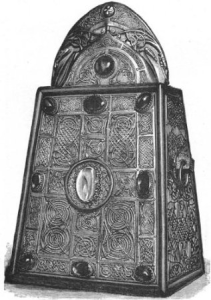The Shrine of St. Patrick's Bell

|
The Shrine of St. Patrick's Bell is a coveted relic in the possession of the Royal Irish Academy in Dublin. When St. Patrick founded his churches throughout Ireland, he is said to have bestowed bells, many of which have become famous in history. One of these relics, a small hand-bell made of two iron plates, about seven inches high and weighing three pounds ten ounces, is especially known as the Bell of the Will of Saint Patrick. It is this object, similar to the sheep bell of today, that has brought us to this story.
Many countries lay claim to be the birthplace of St. Patrick. Patrick's father was named Calpornius and he lived in the village of Bannaven Tabernia. This village no longer exists but it is believed to be somewhere in the British Isles, most likely in Wales. Patrick was born in 385 A.D. and his real name was Maewyn and, until he was about sixteen, he considered himself a pagan. Maewyn's father had a small farm and seems to have been of noble birth, but he speaks of himself as being rude and hated learning. "I, Patrick a sinner, the rudest and the least of all the faithful and most contemptible to very many" is the beginning of his Confession, written by himself and containing most of the few facts known about his life.
We already know that Saint Patrick was abducted by Irish outlaws and became a slave at the age of sixteen. Patrick served as a slave for six years and used to pray day and night. He escaped and, after a brief stay with his parents, went off to Gaul to study Christianity under Saint Germain. Twelve years later he returned to Ireland, determined to convert its pagan inhabitants into the light of Christianity.
At Slane, a hill on the riverside, he built a fire, but was immediately summoned to appear before King Laoghaire who held his court on the neighboring Hill of Tara. The King wanted an answer for why Patrick dared to light a fire which, by ancient custom as well as royal mandate, was not allowed. The meeting between the Saint and the King ended in the King's toleration of the newcomer and, eventually, change in the religion of the whole tribe. This began the apostleship of Saint Patrick who, in the course of his long ministry, traveled most parts of Ireland, baptized many thousands of the natives, planted churches in numerous places, founded schools and established monasteries.
St. Patrick's most famous monastery is that of Armagh, the legend about which is preserved in a celebrated old Irish manuscript known as the Book of Armagh. The Saint begged a certain rich man for some high land upon which to build a church but the man refused him the hill; instead a lower piece of ground near Armagh was offered and Saint Patrick lived there with his followers. Sixty years after the death of Saint Patrick, Saint Columba obtained the bell from the tomb where it had lain on Saint Patrick's breast, and it was bestowed on Armagh as a most precious relic.
Armagh frequently suffered from fires, as the entire village was built of wood. In 1020 it was burned to the ground, except for the library. Then again in May of 1074, it was burned with all its churches and all its bells. But the Bell of Saint Patrick was spared. It was in the custody of a keeper, whose honor depended upon the safety of the trust given him. The keeper of the Bell was the head of the O'Maelchallans and this ancient poem refers to the elected keepers:
Eight who shall be noble illustrious:
A priest and a deacon among them,
That my bell may not deteriorate."
The Bell of Saint Patrick was regarded as more holy as the centuries passed and, by the middle of the eleventh century, anyone who disturbed its sanctity was severely punished. An entry in the Annals of Ulster in 1044 states the following:
"A predatory expedition of Niull, son of Maelsechlainn, King of Ailech, against Ui-Meith and against Cuailgne in which he carried off twelve hundred cows and a multitude of captives in revenge for the violation of the Bell of the Will of St. Patrick."
During the time when Donell MacAulay was Bishop, the sacred bell was enclosed in a beautiful shrine. The inscription that runs around the shrine has been crafted with such skill that the letters appear to be part of the ornamentation. The frame work is of bronze fastened at the corners with copper fluting, and the gold and silver work is riveted to this foundation. The front is divided into thirty-one compartments and a central decoration is adorned with an oval crystal. On the side there are eight Irish serpents whose tails enfold each other so intricately that they appear to be alive. The stones which still remain in place are of little value. The beauty of the gold filigree is beyond expression and photographs poorly represent it. The Shrine of St. Patrick's Bell must be seen to be appreciated.
Over the centuries, the Shrine of St. Patrick's Bell has mostly been in the possession of the descendants of the O'Maelchallans, now known as Mulholland, who were the original keepers of the bell. From time to time, it was briefly kept by others, but always came back to the Mulhollands. Henry Mulholland was the last of the family to possess it. On his death bed, Henry bequeathed the shrine to his old pupil, Adam MacClean, who had shown him kindness throughout his life. Mr. MacClean, in turn, willed the bell and its shrine to Dr. Todd, the great Irish authority on Saint Patrick. Dr. Todd bequeathed it back to the nation at large which leaves it to the care of the Royal Irish Academy as its keepers.
Disclaimer: LittleShamrocks.com is an affiliate website that receives commissions from sales of the products listed. We have purchased and sampled many, but not all, of the products on these pages.
© Copyright LittleShamrocks.com. All Rights Reserved.




